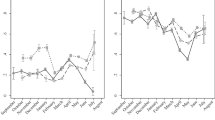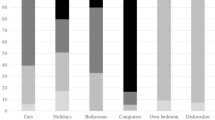Abstract
This study comprises two sub-studies. Study I assessed the test-retest reliability of Family Affluence Scale (FAS II) items among 95 students aged 11 and 15 years old in Beijing. Study II investigated the completion rate of traditional indicators (parents’ educational level, perceived family wealth, resident area, and school location) measuring socioeconomic status (SES) compared with FAS II, and examined the internal reliability, external and construct validity of the FAS II items in a population of 5876 schoolchildren aged 11, 13 and 15 years old in Beijing. Our study found that the FAS II items have high completion rates (> 99%) which are better than other SES indicators. Analyses of reliability showed a moderate internal reliability (Cronbach’s alpha = 0.58) and at least substantial test-retest reliability (ICC > 0.75). Moderate external validity of FAS II was found by Spearman rank correlation between FAS II and other SES indicators (parental education level and perceived family wealth) (r s = 0.48–0.51, p < 0.001) and ordinal regressions. Graphical log-linear Rasch model (GLLRM) showed that FAS has adequate construct validity (few LD and weak DIF). In conclusion, the FAS II is a reliable and valid SES measure for adolescents in the Beijing area.

Similar content being viewed by others
References
Andersen, A., Krølner, R., Currie, C., Dallago, L., Due, P., Richter, M., Orkényi, A., & Holstein, B. E. (2008). High agreement on family affluence between children’s and parents’ reports: international study of 11-year-old children. Journal of Epidemiology and Community Health, 62, 1092–1094.
Beijing Municipal Bureau of Statistics. (2010). Beijing statistical year book. Beijing: China Statistical Publishing House.
Boudreau, B., & Poulin, C. (2009). An examination of the validity of the Family Affluence Scale II (FAS II) in a general adolescent population of Canada. Social Indicators Research, 94, 29–42.
Boyce, W., Torsheim, T., Currie, C., & Zambon, A. (2006). The Family Affluence Scale as a measure of national wealth: validation of an adolescent self-report measure. Social Indicators Research, 78, 473–487.
Carstairs, V., & Morris, R. (1991). Deprivation and health in Scotland. Aberdeen: Aberdeen University Press.
Cho, H. J., & Khang, Y. H. (2010). Family Affluence Scale, other socioeconomic position indicators, and self-rated health among South Korean adolescents: findings from the Korea Youth Risk Behavior Web-based Survey (KYRBWS). Journal of Public Health, 18(2), 169–178.
Currie, C., Elton, R. A., Todd, J., & Platt, S. (1997). Indicators of socioeconomic status for adolescents: the WHO Health Behaviour in School-aged Children Survey. Health Education Research, 12(3), 385–397.
Currie, C., Samdal, O., Boyce, W., & Smith, R. (Eds.). (2001). Health Behaviour in Schoolaged Children: a WHO Cross-National Study (HBSC), Research Protocol for the 2001/2002 Survey. Edinburgh: Child and Adolescent Health Research Unit (CAHRU), University of Edinburgh.
Currie, C., Roberts, C., Morgan, A., Smith, R., Settertobulte, W., Samdal, O., & Barnekow, V. (Eds.). (2004). Young people’s health in context. Copenhagen: WHO Regional Office for Europe.
Currie, C., Molcho, M., Boyce, W., Holstein, B. E., Torsheim, T., & Richter, M. (2008a). Researching health inequalities in adolescents: the development of the Health Behaviour in School-Aged Children (HBSC) Family Affluence Scale. Social Science & Medicine, 66, 1429–1436.
Currie, C., Nic Gabhainn, S., Godeau, E., Roberts, C., Smith, R., Currie, D., Pickett, W., Morgan, A., & Barnekow, V. (Eds.). (2008b). Inequalities in young people’s health: HBSC international report from the 2005/2006 survey. Copenhagen: WHO Regional Office for Europe.
Dalstra, J., Kunst, A., & Mackenbach, J. (2006). A comparative appraisal of the relationship of education, income and housing tenure with less than good health among the elderly in Europe. Social Science & Medicine, 62, 2046–2060.
Goodman, E. (1999). The role of socioeconomic status gradients in explaining differences in US adolescents’ health. American Journal of Public Health, 89, 1522–1528.
Goodman, E., Adler, N. E., Kawachi, I., Frazier, A. L., Huang, B., & Colditz, G. A. (2001). Adolescents’ perceptions of social status: development and evaluation of a new indicator. Pediatrics, 108(2), 1–8.
Finney, S. J., & DiStefano, C. (2006). Non-normal and categorical data in structural equation modeling. In G. R. Hancock & R. O. Mueller (Eds.), Structural equation modeling: A second course. Greenwich: Information Age Publishing.
Kreiner, S. (2009). A guided tour through DIGRAM 2.0: Analysis of contingency tables by chain graph models. Copenhagen: Department of Biostatistics, University of Copenhagen.
Landis, J. R., & Koch, G. G. (1977). The measurement of observer agreement for categorical data. Biometrics, 33, 159–174.
Li, H., & Zhu, Y. (2006). Income, income inequality, and health: evidence from China. Journal of Comparative Economics, 34, 668–693.
Lin, Y. C. (2011). Assessing the use of the Family Affluence Scale as socioeconomic indicators for researching health inequalities in Taiwan adolescents. Social Indicators Research, 102, 463–475.
Liu, Y., Hsiao, W., & Eggleston, K. (1999). Equity in health and health care: the Chinese experience. Social Science & Medicine, 49, 1349–1356.
Liu, Y., Wang, M., Tynjälä, J., Lv, Y., Villberg, J., Zhang, Z., & Kannas, L. (2010). Test-retest reliability of selected items of Health Behaviour in School-aged Children (HBSC) survey questionnaire in Beijing, China. BMC Medical Research Methodology, 10, 73.
Maes, L., Vereecken, C., Vanobbergen, J., & Honkala, S. (2006). Tooth brushing and social characteristics of families in 32 countries. International Dental Journal, 56, 159–167.
Marmot, M. (2005). Social determinants of health inequalities. The Lancet, 365, 1099–1104.
Molcho, M., Nic Gabhainn, S., & Kelleher, C. (2007). Assessing the use of the Family Affluence Scale (FAS) among Irish schoolchildren. Irish Medical Journal, 100(8), 37–39.
Muthén, L. K., & Muthén, B. O. (2010). Mplus User’s Guide (6th ed.). Los Angeles: Muthén & Muthén.
Ostrove, J. M., & Adler, N. E. (1998). Socioeconomic status and health. Current Opinion in Psychiatry, 11, 649–653.
Pickett, W., Molcho, M., Simpson, K., Janssen, I., Kuntsche, E., Mazur, J., Harel, Y., & Boyce, W. (2005). Cross-national studyof injury and social determinants in adolescents. Injury Prevention, 11, 213–218.
Richter, M., Erhart, M., Vereecken, C. A., Zambon, A., Boyce, W., & Gabhainn, S. N. (2009). The role of behavioural factors in explaining socio-economic differences in adolescent health: A multilevel study in 33 countries. Social Science & Medicine, 69(3), 396–403.
Ritterman, M. L., Fernald, L. C., Ozer, E. J., Adler, N. E., Gutierrez, J. P., & Syme, S. L. (2009). Objective and subjective social class gradients for substance use among Mexican adolescents. Social Science & Medicine, 68, 1843–1851.
Rosenbaum, P. R. (1989). Criterion-related construct validity. Psychometrika, 54, 625–633.
Schnohr, C., Kreiner, S., Due, P., Currie, C., Boyce, W., & Diderichsen, F. (2008). Differential item functioning of a family affluence scale: validation study on data from HBSC 2001/02. Social Indicators Research, 89(1), 79–95.
Shrout, P. E., & Fleiss, J. L. (1979). Intraclass correlations: use in assessing rater reliability. Psychological Bulletin, 86(2), 420–428.
Starfield, B., Riley, A. W., Witt, W. P., & Robertson, J. (2002). Social class gradients in health during adolescence. Journal of Epidemiology and Community Health, 56, 354–361.
Torsheim, T., Currie, C., Boyce, W., Kalnins, I., Overpeck, M., & Haughland, S. (2004a). Material deprivation and self-rated health: a multilevel study of adolescents from 22 European and North American countries. Social Science & Medicine, 59(1), 1–12.
Torsheim, T., Valimaa, R., & Danielson, M. (2004b). Health and well-being. In C. Currie, C. Roberts, A. Morgan, R. Smith, W. Settertobulte, O. Samdal, & V. Barnekow Rasmussen (Eds.), Young people’s health in context: Health Policy for children and adolescents no. 4 (pp. 55–62). Copenhagen: WHO Regional Office for Europe.
Torsheim, T., Currie, C., Boyce, W., & Samdal, O. (2006). Country material distribution and adolescents’ perceived health: multilevel study of adolescents in 27 countries. Journal of Epidemiology and Community Health, 60, 156–161.
Townsend, P. (1987). Deprivation. Journal of Social Policy, 16(2), 147–164.
Wardle, J., Robb, K., & Johnson, F. (2002). Assessing socioeconomic status in adolescents: the validity of a home affluence scale. Journal of Epidemiology and Community Health, 56, 595–599.
Wardle, J., Robb, K. A., Johnson, F., Griffith, J., Brunner, E., Power, C., & Martin, T. (2004). Socioeconomic variation in attitudes to eating and weight in female adolescents. Health Psychology, 23(3), 275–282.
West, P. (1997). Health inequalities in the early years: is there equalization in youth? Social Science and Medicine, 44, 833–858.
West, P., & Sweeting, H. (2004). Evidence on equalization in health in youth from the West of Scotland. Social Science & Medicine, 59(1), 13–27.
Acknowledgements
The authors would like to thank Ms. Lanmin Xiao from Beijing Experimental School of Xicheng District and Ms. Jing Tian from Beijing Academy of Educational Sciences for helping to organize and conduct the field work. The authors also would like to thank Mr. Michael Ormshaw for checking the language of the manuscript. As a part of joint research project, this study was supported by the China Institute of Sport Science (CISS) and the Research Centre for Health Promotion at the Department of Health Science in the University of Jyväskylä. The survey and data collection were funded by the CISS. During this research, the first author was supported by grants from the Finnish Foundation for Alcohol Studies and the University of Jyväskylä.
Author information
Authors and Affiliations
Corresponding author
Rights and permissions
About this article
Cite this article
Liu, Y., Wang, M., Villberg, J. et al. Reliability and Validity of Family Affluence Scale (FAS II) among Adolescents in Beijing, China. Child Ind Res 5, 235–251 (2012). https://doi.org/10.1007/s12187-011-9131-5
Accepted:
Published:
Issue Date:
DOI: https://doi.org/10.1007/s12187-011-9131-5




